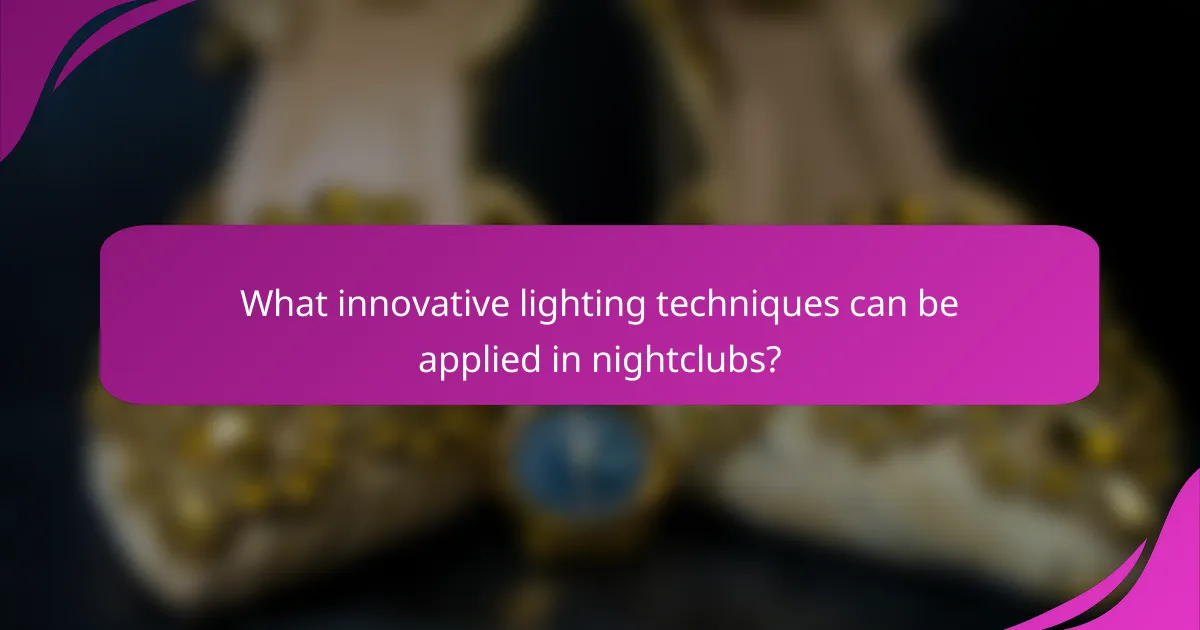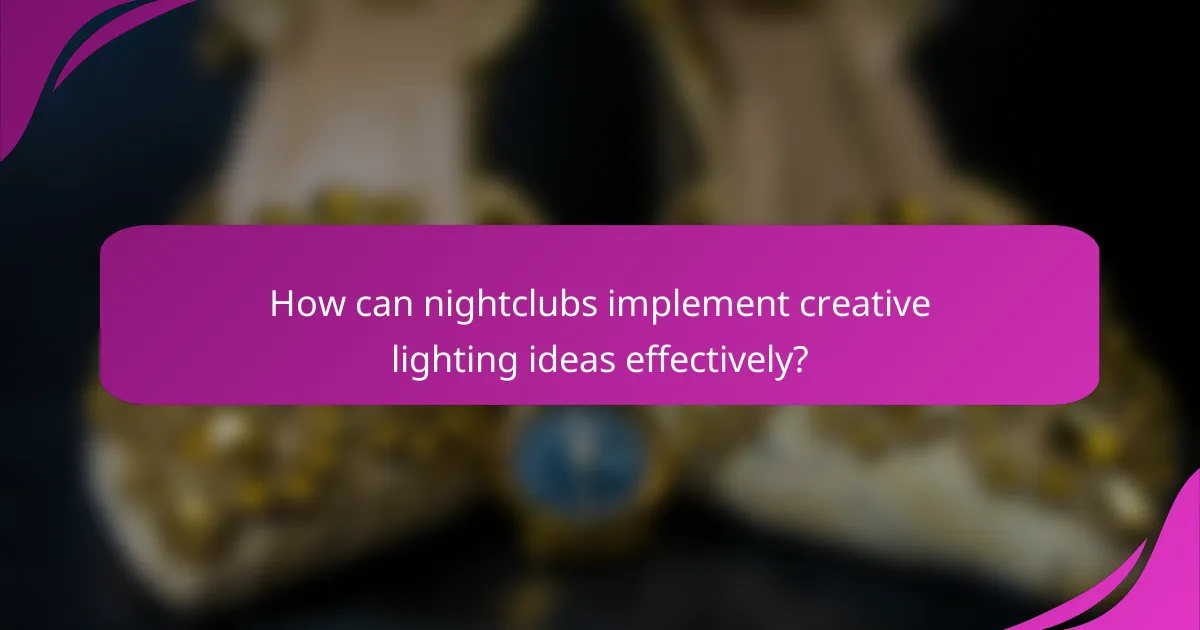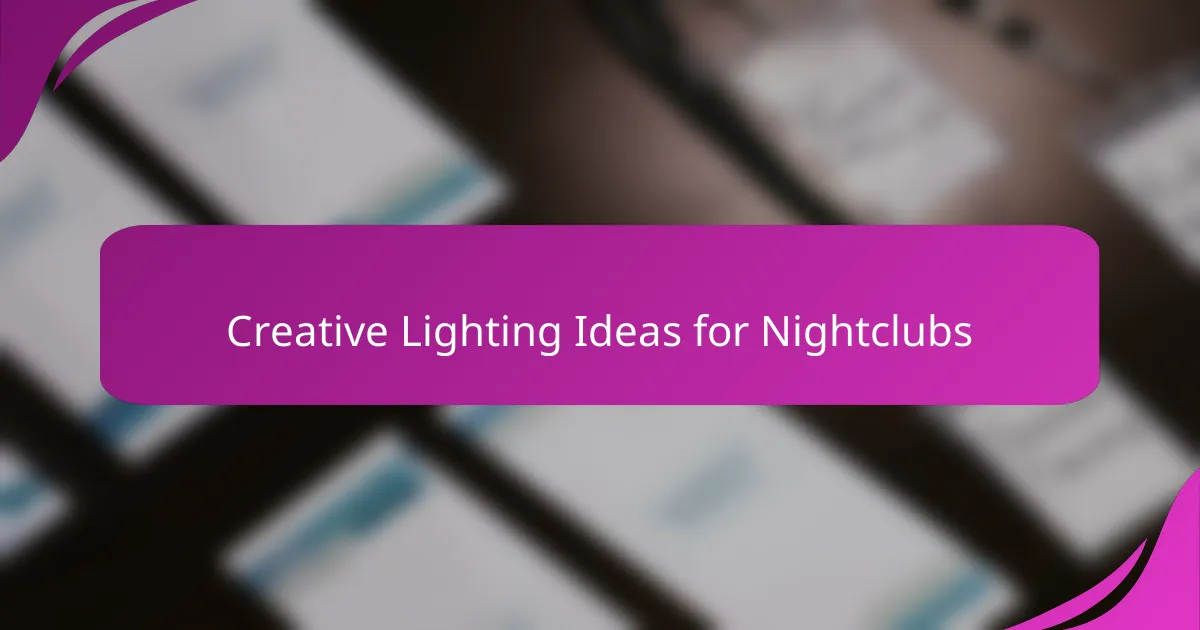Creative lighting ideas for nightclubs focus on utilizing various technologies to enhance the ambiance and overall experience for patrons. Key elements include LED wall panels that provide dynamic visuals, moving head lights for versatile beam direction, and laser displays that create dramatic effects with colorful patterns. Strobe lights energize crowds by synchronizing with music, while uplighting highlights architectural features of the venue. Additionally, interactive lighting systems engage guests by responding to music, and projection mapping transforms surfaces into vibrant displays. These innovative techniques are essential for attracting larger crowds and improving the nightlife atmosphere.

What are Creative Lighting Ideas for Nightclubs?
Creative lighting ideas for nightclubs include LED wall panels, moving head lights, and laser displays. LED wall panels can create immersive backgrounds and dynamic visuals. Moving head lights offer versatility in directing beams across the dance floor. Laser displays add a dramatic effect, enhancing the atmosphere with colorful patterns. Strobe lights can energize crowds, synchronizing with the beat of the music. Uplighting can transform the venue by highlighting architectural features. Additionally, interactive lighting systems respond to music, engaging patrons in a unique experience. These methods are proven to enhance ambiance and draw in larger crowds, making them effective for nightclub environments.
How can lighting enhance the nightclub experience?
Lighting significantly enhances the nightclub experience by creating an immersive atmosphere. It influences mood and energy levels, making the environment more engaging. Dynamic lighting patterns can synchronize with music, enhancing the overall sensory experience. Specific colors can evoke different emotions; for example, red can increase excitement, while blue can create a calming effect. Studies show that well-designed lighting can increase customer satisfaction and encourage longer stays. Effective lighting design can also highlight architectural features, making the space visually appealing. Additionally, lighting can guide movement and flow within the club, improving navigation and crowd management. Overall, lighting is crucial for setting the tone and enhancing the nightlife experience.
What emotions can different lighting colors evoke in a nightclub setting?
Different lighting colors can evoke specific emotions in a nightclub setting. Red lighting often stimulates excitement and passion. It can create an intense atmosphere that encourages energetic dancing. Blue lighting tends to evoke calmness and relaxation. This color can create a more laid-back vibe, allowing patrons to socialize comfortably. Green lighting is associated with balance and harmony. It can promote a sense of well-being among club-goers. Yellow lighting often generates feelings of happiness and cheerfulness. This color can enhance the overall mood and create a vibrant environment. Purple lighting is linked to creativity and mystery. It can add an element of intrigue to the nightclub experience. These emotional responses to lighting colors are supported by studies in color psychology, which show that colors significantly influence human emotions and behaviors.
How does lighting influence the overall atmosphere of a nightclub?
Lighting significantly influences the overall atmosphere of a nightclub. It affects mood, energy levels, and guest interactions. Dim lighting can create an intimate and relaxed environment. In contrast, bright, colorful lights can energize the space and encourage dancing. The use of dynamic lighting effects, such as strobes and lasers, can enhance excitement and engagement. Research indicates that lighting impacts psychological responses, with studies showing that specific colors can evoke different emotions. For instance, blue light is often associated with calmness, while red light can stimulate energy and passion. Thus, effective lighting design is crucial for shaping a nightclub’s ambiance and overall guest experience.
What types of lighting are commonly used in nightclubs?
Common types of lighting used in nightclubs include LED lights, strobe lights, and laser lights. LED lights provide vibrant colors and energy efficiency. Strobe lights create dynamic visual effects by flashing rapidly. Laser lights produce sharp beams that enhance the atmosphere. Additionally, uplighting is often used to illuminate walls and create depth. Moving head lights can change positions and colors, adding versatility. These lighting types contribute to the overall ambiance and experience in nightclubs.
What are the benefits of using LED lighting in nightclubs?
LED lighting in nightclubs offers energy efficiency, vibrant colors, and enhanced ambiance. These lights consume significantly less energy compared to traditional lighting, reducing operational costs. LED lights also have a longer lifespan, lasting up to 25,000 hours. This minimizes replacement frequency and maintenance costs.
The versatility of LED lighting allows for dynamic color changes and effects, creating engaging visual experiences. This adaptability supports various themes and moods throughout the night. Additionally, LED lights produce less heat, ensuring a comfortable environment for patrons.
According to a study by the U.S. Department of Energy, LED lighting can reduce energy consumption by up to 75%. This statistic highlights the substantial savings for nightclub owners. Overall, the benefits of LED lighting contribute to a more enjoyable and cost-effective nightclub experience.
How do laser lights contribute to a nightclub’s visual appeal?
Laser lights enhance a nightclub’s visual appeal by creating dynamic and engaging light displays. These lights can produce vibrant colors and intricate patterns that captivate the audience. They help establish an energetic atmosphere, encouraging patrons to dance and socialize. Laser lights can also sync with music, providing a multisensory experience. This synchronization amplifies the emotional response of attendees, making the environment more immersive. According to a study by the Journal of Environmental Psychology, visual stimuli like laser lights can increase feelings of excitement and enjoyment in social settings. Thus, laser lights play a crucial role in elevating the overall nightclub experience.

What innovative lighting techniques can be applied in nightclubs?
Innovative lighting techniques for nightclubs include LED wall panels, laser shows, and intelligent lighting systems. LED wall panels can create dynamic visuals and patterns that enhance the atmosphere. Laser shows provide stunning visual effects that can synchronize with music, creating an immersive experience. Intelligent lighting systems use automated fixtures to adjust brightness and color based on the mood of the event. Additionally, projection mapping can transform surfaces into vibrant displays, adding depth to the environment. These techniques can significantly enhance the overall nightclub experience, making it more engaging for patrons.
How can dynamic lighting change the mood during an event?
Dynamic lighting can significantly alter the mood during an event. It creates an immersive atmosphere that influences emotions and interactions. Different colors and intensities evoke specific feelings. For example, warm colors like red and orange can create excitement. Conversely, cooler colors like blue and green promote calmness. The timing and movement of lights can also enhance the experience. Pulsating lights can energize the crowd, while soft fades can encourage relaxation. Studies show that lighting impacts mood perception and social behavior. Effective use of dynamic lighting can lead to a memorable event experience.
What are some examples of dynamic lighting systems used in nightclubs?
Examples of dynamic lighting systems used in nightclubs include LED wall systems, moving head lights, and laser light shows. LED wall systems create vibrant visual displays that can change color and pattern. Moving head lights can pan, tilt, and change colors, providing versatile lighting effects. Laser light shows produce intricate patterns and beams that enhance the atmosphere. Additionally, intelligent lighting systems can be programmed to sync with music, creating an immersive experience. These technologies are widely adopted in the nightclub industry to elevate the overall ambiance and engage patrons.
How can DJs synchronize lighting with music beats?
DJs synchronize lighting with music beats using software and hardware tools. They often utilize DMX controllers to manage lighting fixtures. These controllers allow DJs to program light patterns that match the rhythm of the music. Additionally, many DJs use audio analysis software to detect beats in real-time. This software can trigger lighting changes based on the tempo and dynamics of the music.
Some lighting systems can automatically sync to the beat without manual input. This feature enhances the overall experience by creating a cohesive atmosphere. Studies have shown that synchronized lighting can increase audience engagement by up to 30%. Therefore, effective synchronization of lighting and music beats is crucial for a successful performance.
What role does color play in nightclub lighting design?
Color plays a crucial role in nightclub lighting design. It influences the mood and atmosphere of the space. Different colors evoke various emotional responses. For instance, red can create a sense of excitement, while blue often promotes calmness. The use of color can enhance the overall experience for patrons. Studies show that well-designed lighting can increase customer satisfaction. Color also helps in defining different areas within the club. For example, warm colors might be used in lounge areas, while vibrant colors can energize dance floors. Ultimately, color in lighting design contributes significantly to the nightclub’s identity and appeal.
How can color-changing lights be effectively utilized in a nightclub?
Color-changing lights can be effectively utilized in a nightclub by creating dynamic atmospheres. These lights can shift colors in sync with music beats, enhancing the overall experience. They can be programmed for specific themes or events, allowing for customized lighting setups. Strategic placement of these lights can highlight dance floors, bars, and lounge areas. Utilizing remote control systems enables quick adjustments to lighting moods. Studies show that lighting significantly impacts patrons’ emotions and behaviors in nightlife settings. For instance, a well-lit environment can increase energy levels and encourage more prolonged stays.
What are the psychological effects of specific colors in nightlife environments?
Specific colors in nightlife environments can significantly influence mood and behavior. For instance, red often evokes excitement and passion, making it popular in nightclubs. Blue can create a calming effect, promoting relaxation among patrons. Yellow tends to elicit feelings of happiness and energy, enhancing social interaction. Green is associated with balance and harmony, often used to create a refreshing atmosphere.
Research indicates that color can impact emotional responses and decision-making. A study by K. A. Valdez and A. Mehrabian found that warm colors like red and orange increase arousal levels. Conversely, cool colors such as blue and green can decrease arousal and promote tranquility.
These psychological effects can shape the overall experience in nightlife settings, influencing everything from the choice of drink to social engagement. Understanding these effects helps nightclub designers create environments that align with desired atmospheres and experiences.

How can nightclubs implement creative lighting ideas effectively?
Nightclubs can implement creative lighting ideas effectively by using a combination of LED technology and dynamic programming. LED lights are energy-efficient and versatile, allowing for a wide range of colors and effects. Dynamic programming enables synchronization of lights with music, enhancing the overall experience.
Additionally, incorporating moving lights can create visual interest and excitement. Using spotlights to highlight performers or specific areas can draw attention where needed. Layering different types of lighting, such as ambient, task, and accent lights, provides depth and atmosphere.
Regularly updating lighting designs keeps the environment fresh and engaging. According to a study by the Journal of Environmental Psychology, effective lighting can significantly influence patrons’ mood and behavior in nightlife settings.
What are the best practices for designing a lighting layout?
The best practices for designing a lighting layout include understanding the space and its purpose. Assess the dimensions and layout of the nightclub. Identify key areas such as dance floors, bars, and seating. Choose lighting fixtures that enhance the atmosphere. Use a combination of ambient, task, and accent lighting. Layering these types creates depth and interest. Consider the color temperature of lights to match the desired mood. Implement dimmers for adjustable brightness levels. Finally, ensure proper placement to minimize shadows and glare. These practices optimize the nightclub experience and enhance visual appeal.
How can lighting placement affect visibility and ambiance in a nightclub?
Lighting placement directly influences visibility and ambiance in a nightclub. Properly positioned lights enhance the overall atmosphere and guide guest movement. For instance, overhead lighting can create a bright, energetic environment, while low-level lighting promotes intimacy. Spotlights can highlight performers or specific areas, drawing attention where needed. In contrast, poorly placed lights can create harsh shadows or overly bright spots, disrupting the experience. Studies have shown that well-designed lighting can increase patron satisfaction by up to 30%. Effective lighting design considers color temperature and intensity, affecting mood and energy levels. Thus, strategic lighting placement is essential for creating the desired nightclub experience.
What safety considerations should be taken into account when installing nightclub lighting?
When installing nightclub lighting, several safety considerations must be addressed. First, ensure that all electrical installations comply with local codes. This prevents electrical hazards and ensures safe operation. Second, use fixtures that are rated for the intended environment, especially in areas with high humidity or heat. Third, consider the placement of lights to avoid glare and blind spots that may obstruct visibility. Fourth, ensure that all wiring is properly insulated and secured to prevent tripping hazards. Additionally, use circuit breakers and fuses to protect against overloads. Regular maintenance checks are also essential to identify and rectify any potential hazards. Proper signage should indicate areas with intense lighting to warn patrons. These measures collectively enhance safety in nightclub lighting installations.
What are some common challenges in nightclub lighting design?
Common challenges in nightclub lighting design include achieving the right ambiance, managing energy efficiency, and ensuring safety. The ambiance must match the club’s theme and attract patrons. Energy efficiency is crucial due to high electricity costs associated with extensive lighting. Safety concerns arise from potential hazards, such as tripping over cables or inadequate visibility. Additionally, balancing different light sources can be difficult. For instance, combining LED lights with traditional fixtures requires careful planning to avoid harsh contrasts. Finally, maintenance of complex lighting systems can be labor-intensive and costly. These challenges must be addressed to create an effective lighting design that enhances the nightclub experience.
How can nightclubs address issues with lighting maintenance?
Nightclubs can address issues with lighting maintenance by implementing regular inspection schedules. Frequent checks can identify malfunctioning lights before they affect the ambiance. Nightclubs should also invest in quality lighting fixtures that require less maintenance. Using LED lights can reduce energy costs and extend lifespan. Establishing a dedicated maintenance team ensures prompt repairs and replacements. Keeping an inventory of spare bulbs and fixtures minimizes downtime. Training staff on basic troubleshooting can empower quick fixes. Documenting maintenance activities helps track performance and plan future upgrades.
What solutions exist for minimizing energy consumption in nightclub lighting?
Energy-efficient lighting solutions for nightclubs include LED lighting and smart lighting controls. LED lights consume up to 75% less energy than traditional incandescent bulbs. They also have a longer lifespan, reducing replacement costs. Smart lighting controls allow for automated dimming and scheduling, optimizing energy use based on occupancy. Utilizing motion sensors can further reduce energy consumption by turning lights off when areas are unoccupied. Additionally, integrating daylight sensors can adjust artificial lighting based on natural light levels. These solutions collectively contribute to significant energy savings and lower operational costs in nightclub lighting.
What tips can enhance the effectiveness of nightclub lighting?
To enhance the effectiveness of nightclub lighting, focus on creating a dynamic atmosphere. Utilize a combination of color-changing LED lights to engage patrons. Incorporate strobe lights to add excitement during peak moments. Use spotlights to highlight performers or special areas. Ensure that lighting is adjustable to accommodate different music tempos. Layer lighting effects to create depth and visual interest. Position lighting fixtures strategically to avoid glare and shadows. Regularly update lighting designs to keep the experience fresh and appealing.
How can nightclubs create a cohesive theme using lighting?
Nightclubs can create a cohesive theme using lighting by strategically designing the lighting elements to match the desired atmosphere. Consistent color schemes should be employed throughout the space to reinforce the theme. For example, using deep blues and purples can create a moody, intimate vibe.
Incorporating dynamic lighting effects, such as moving lights or strobe lights, can enhance the energy of the theme during peak hours. The placement of lights should also be considered to highlight specific areas, like dance floors or bars, aligning with the overall design concept.
Utilizing themed projections can further immerse guests in the experience, tying visuals to the music and ambiance. According to a study by the Journal of Environmental Psychology, lighting significantly influences mood and behavior in social settings. This evidence supports the idea that well-planned lighting can effectively unify a nightclub’s theme.
What are some cost-effective lighting solutions for smaller venues?
LED lighting is a cost-effective solution for smaller venues. LED lights consume less energy, which reduces electricity bills. They have a longer lifespan compared to traditional bulbs, lasting up to 25,000 hours. This longevity means less frequent replacements, saving on maintenance costs. Additionally, LED lights are available in various colors and styles, providing flexibility in design. Smart lighting systems can also be integrated, allowing for programmable settings and remote control. These features enhance the venue’s atmosphere while keeping costs low.
Creative lighting ideas for nightclubs focus on enhancing the atmosphere and experience through various innovative techniques. Key lighting elements include LED wall panels, moving head lights, strobe lights, and laser displays, all contributing to an immersive environment. The article explores how different colors impact emotions, the role of dynamic lighting in shaping mood, and best practices for effective lighting design. It also addresses energy efficiency, safety considerations, and maintenance challenges, providing a comprehensive overview of how to implement and optimize nightclub lighting.
